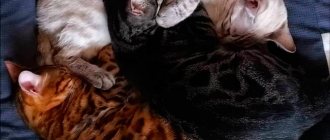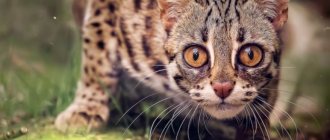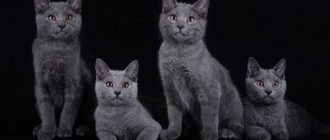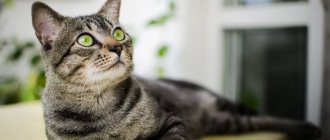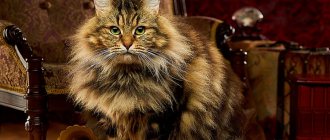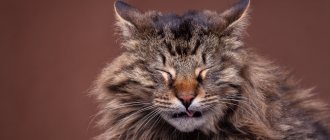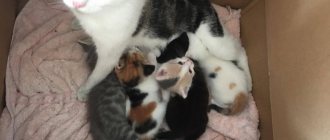History of the origin of the domestic Bengal breed
global $ads_google;
//data-ad-slot=”2475549904″ $ads_google = empty($ads_google) ? false : true; ?> if ($ads_google == false) {?> $ads_google = true; ?> } ?> The goal of breeding the Bengal cat, the founder of the breed, American Jane Mill, considered obtaining a domestic cat that preserved the color of its wild ancestors - this would help focus attention on the serious problem of extermination of leopard cats.
The history of the origin of the Bengal breed began almost 60 years ago, in 1961, when Jane came to Bangkok. This trip became fateful: there she received a baby Asian leopard cat, which is almost impossible to tame. The purchased baby received the name Malaysia and settled down with the new owner. The grown cat gave birth to offspring from a domestic shorthair cat, but the vicissitudes of fate did not allow her to start breeding a new breed.
A new attempt was made by Jane in 1980. She was provided with 9 hybrids of a leopard cat and domestic cats of different breeds. Then Mill fell into the hands of an Indian cat with a golden-orange color, which gave the Bengals a shiny coat called glitter.
The work was long and difficult due to many factors, and ended in success and recognition by the early 90s.
History of the breed
The Bengals owe their existence to Jean Mill. American. Biologist-geneticist. 1961 Jin goes on a trip to Bangkok. Habitat of wild cats Felis Bengalensis. The beautiful and valuable skin of animals has traditionally attracted poachers. The hunt was carried out mercilessly. What brought the breed to the threshold of extinction.
Jean Mill decided to draw public attention to the problem of the extermination of the leopard cat. A woman returned to the States with a leopard kitten named Malaysia.
The kitty turned out to be completely non-aggressive, despite her wild appearance. But it was difficult to call her social either. No displays of affection. Most often she spent time alone with herself.
However, Mill's pet cat melted the heart of unapproachable Malaysia. The cub turned out to be absolutely healthy with an unusually beautiful exotic color. This is how the idea of creating a new breed of cats with a wild appearance and domestic habits was born. Unfortunately, life circumstances did not allow us to begin implementation right away.
Fifteen years later, Jean continued to work on creating a new breed. At the University of California, they were crossbreeding wild leopard cats with domestic cats. For the purpose of researching feline leukemia. Mill was able to get herself 9 first generation hybrid females. Work began on the creation of the Bengal breed. The Indian wild cat put the icing on the cake. Its spotted color was red-golden. The kittens turned out beautiful with amazingly shiny fur.
The Bengal cat breed was officially registered in 1991. In 1997, domestic leopard cats began to conquer Russia.
Description and standards of Bengal cats
It is impossible not to notice the external features of an exotic cat. Even when very small, the baby Bengal looks like a leopard. An adult Bengal cat receives the highest reviews and, just from one verbal description, is a true beauty.
According to the WCF standard, the breed must have a number of characteristics.
The head is a wedge with a massive chin and thickened chin pads. Thanks to this structural feature, the animal’s muzzle resembles a tiger’s mouth. This similarity is even more noticeable during yawning, meowing or growling.
The ears are short and set high on the head. They are wide at the base and their tips are rounded.
The nose is large, curved and moderately wide.
The eyes are almond-shaped and very beautiful. Eye color is clear green or golden.
The head is located on a thick and strong neck, which is in ideal proportions in relation to both the head and the body.
A cat of this breed has a large body and strong muscles.
Bengals run around the house on round, large and powerful paws. As usual, the length of the hind legs exceeds the length of the front ones.
The tail is medium in size, does not fluff, and is dense to the touch. The domestic leopard's tail has spots or rings.
Bengals are short-haired creatures with a soft, silky coat.
When interested in a description of a particular cat breed, people who are allergic to the Fel D1 protein first of all find out whether this charming creature is a hypoallergenic animal. Despite the fact that shedding almost does not affect these cats, they themselves carry the entire allergen on their skin.
global $ads_google; //data-ad-slot=”2475549904″ $ads_google = empty($ads_google) ? false : true; ?> if ($ads_google == false) {?> $ads_google = true; ?> } ?>
The breed presents a wealth of colors. A popular color is spotted-striped. This variety has shades of gray, white or red.
The most common and characteristic color of the Leopardette breed makes the cat look like a leopard.
“Sorrel” in cats finishes forming closer to the year. The coat is golden, the spots are chocolate brown, and the tip of the tail is black.
A sign of the marbled variety is spots of a peculiar, non-leopard shape.
Cats in white and gray colors are called "snow leopards". Kittens are born white, only later acquiring their characteristic color.
The colors of the Bengal breed also be called: rosette on gold, rosette on silver, marble on gold, marble on silver, seal links point, seal mink, seal sepia, charcoal, blue.
Glitter and phasing in Bengal kittens
Fazing in Bengal kittens is the process when babies from one month to four months are covered with gray or dull white fur. The name of the process comes from the English word fuzzy - unclear, uncertain. When the baby is more than a month old, the owner suddenly notices that the appearance of the young Bengal is changing. His fur becomes strewn with protruding whitish hairs, and the cat looks shaded. If phasing is severe, it makes it very difficult to see the pattern and color of the skin. The full beauty of the fur coat returns to eight months of the animal’s life.
Phasing does not manifest itself in every Bengal kitten.
The breed is characterized by glitter - a particularly strong shine to the coat. This is not a mandatory parameter for exhibitions; you can purchase a cat with or without glitter, since the standard allows both types for all representatives of the breed.
Dimensions and weight of Bengals
When buying such a pet for a home, the owner should imagine how big a Bengal cat grows. The height of an adult animal at the withers is 40-41 cm. The animal grows to this established norm by 1.5 years, but the complete completion of growth processes is completed by the age of two years.
The typical weight of purebred cats is 3.5-5.5 kg. An adult male is more massive than a female and weighs 5-8 kg. Animals of both sexes are larger and smaller than the declared weight, but this does not happen often.
If a cat seems very large and its weight is quite high, this does not mean that obesity has appeared: Bengals are nimble and energetic creatures, and, most likely, their body weight is due to the pet’s excellent physical shape and well-developed muscles.
The body length of an adult handsome leopard is about 90 cm, and the height at the withers is 40-41 cm.
global $ads_google;
//data-ad-slot=”2475549904″ $ads_google = empty($ads_google) ? false : true; ?> if ($ads_google == false) {?> $ads_google = true; ?> } ?> Table of weight of Bengal cats by month
| Age | Female | Male |
| newborn | 65-110 gr | 70-125 gr |
| 1 month | 350-500 gr | 390-560 gr |
| 2 months | 640-1100 gr | 750-1300 gr |
| 3 months | 1.2-1.6 kg | 1.3-2.2 kg |
| 4 months | 1.7-2.6 kg | 2.5-3 kg |
| 5 months | 2.5-3.1 kg | 2.8-4 kg |
| 6 months | 2.8-3.9 kg | 3.1-4.3 kg |
| 8 months | 3.2-4.8 kg | 3.7-5.1 kg |
| 10 months | 3.3-5 kg | 4.3-5.6 kg |
| 1 year | 3.4-5.2 kg | 4.8-6.3 kg |
| 2 years | 3.5-5.5kg | 5-8 kg |
Description of the Asian leopard cat
Adult representatives of Prionailurus bengalensis are the same in size as domestic ones, but more slender. Animals weigh 3.2–4.8 kg in the southern regions of their range, where their number is maximum. The northwest of China is inhabited by small predators weighing 1.5–3.8 kg. The Far Eastern subspecies is much larger: the weight of the cat in winter is 6.8–7.0 kg. The height at the withers does not exceed 40 cm.
External features
The body of the Asian leopard cat is elongated, with an average length of 39–45 cm plus a tail of 17–20 cm. The hind limbs are more powerful and higher than the front ones, which allows the animal to follow the trail of prey for a long time, as well as jump on tree branches.
Interestingly, the cat's toes are slightly webbed. This feature helps the animal swim and also allows it to move on slippery ground.
The head shape is narrow. The dark brown ears are rounded at the ends and have a white spot in the center on the outside. The nose is large, convex, slightly forked. The eyes are large, round, brown. Under the lower eyelids there is a small white spot against a dark background. In its appearance it resembles a tear. Two black-brown stripes go from the eyes to the ears and small light lines go down to the nose. The area around the mouth and mustache is white.
The fur of wild leopard cats has a special spotted pattern.
The Asian leopard cat has short, thick fur. The guard hairs are soft. The main coat color is brown. Shades vary from yellowish and reddish in the southeast of the range to grayish in the north. The body and legs are marked with black spots of varying sizes. The belly, chest and lower part of the neck are white or cream in color and have transverse dark stripes. Along the back, a pattern of dots forms chains resembling lines. The color of large spots is solid or rosette, where the center is lighter and the edges are almost black. The fur from the middle of the tail is decorated with 5–6 pale rings, the tip is dark.
Character
In nature, a nocturnal predator treats humans with distrust and fear, trying in any way to avoid meeting him. Taming these animals is not always successful, especially if the kitten is older than two months. It is possible to establish contact with him only at an early age. Then the baby will forget his forest origins and learn skills for living next to people.
Those with beautiful spotted fur have an independent character. It is admired by its owners. The animals are very affectionate. They love to have their back scratched and their neck stroked. Pets participate in all events taking place in the house and accompany every step of the owner during the day. Having discovered a container of water, the spotted creatures immediately begin to splash around in it. These cats are not afraid to get their fur wet, as they are accustomed to the humid climate in their homeland.
Video: kittens playing with water
The cunning creatures are observant and quickly learn how to turn on the faucet, and can cause a flood if the animals are left unattended. They know how to use the toilet. They love to climb to great heights and jump off deftly without getting injured. They perceive all small objects as prey and carry them around the house in their teeth. Animals are tireless in play, athletic and playful. They know their name and are very trainable. They meow almost like domestic cats, quietly and pleasantly.
But it can be very difficult for owners to adapt to the active lifestyle of their pets. We have to get used to the fact that leopard cats don't sleep at night. This is where the hunting instinct comes into play. Animals require constant human attention, otherwise they will go wild and begin to show aggression towards others. Here is a case of failed domestication. When purchasing a kitten without documents, a resident of the capital of Thailand had no idea about the difficulties he would have to face. A baby named Tiger moved into a multi-storey apartment. There were two other domestic cats in the family. The owners hoped that the kitten would easily make friends with them, learn to use the litter box and get used to people. The newcomer did not like that attention was paid not only to him, but also to other pets. Out of jealousy, the forest animal began to hiss and growl at all the inhabitants of the apartment. He calmed down when petted, but did not give in to hands. Perhaps the reason for this was insufficient daily communication with the owner. Growing up, the pet stopped accepting human affection, became more and more aggressive and began to offend other cats. The owners realized that they could not cope with the animal and took it to a wildlife center for rehabilitation. The cat was already 6 months old. Volunteers had to teach him survival skills before releasing him back into the forest. There, Tiger’s former caregivers were given the address of a nursery where they breed Asian leopard cats for home keeping. Six months later, a tame kitten appeared in the family. He became everyone's favorite and the pride of his owners.
Habitat
The wild Bengal cat is found across a vast territory of two dozen Asian countries. The eastern part of the range begins in Pakistan. Next - India, Bangladesh and states to the south down to Malaysia, as well as the islands of Indonesia. In the west, the Asian leopard cat's home range extends from the Amur River in the Russian Far East to the Philippine Islands. Animals were found in the Himalayas at altitudes of up to 3100 m above sea level. Fans of night hunting cannot stand the heat of +35°C and drought, so they are not found in the steppe regions.
Typical habitats include:
- low-lying river banks;
- tropical rainforests;
- shrubs;
- swamps;
- meadows and pastures;
- agricultural areas.
The hunting territory of one animal is 1.15 km2 in Singapore, where only 89 animals live. This is a minimal site size compared to 2.5 km2 in Malaysia and 3.5 km2 in Borneo. The size depends on the amount of food resources, as well as on human activity in the habitats of the spotted predator. Cats mark their “possessions” by scratching trees and feces all over, and not just along the border.
Asian leopard cat likes to rest in trees
During the day, the dwarf predator sleeps in a shelter, most often in trees. In the evening and at night it hunts, setting up an ambush or tracking prey by smell. The short-haired animal also has sharp eyesight and excellent hearing, which allows it to always be well-fed. Can swim. This ability helped the animal to populate islands located a short distance from each other.
Interestingly, the Asian leopard cat, in pursuit of game, reaches speeds of up to 72.4 kilometers per hour, which is 1.6 times faster than a domestic cat.
This species of spotted animals has adapted better than others to human changes in their habitats. Animals settle in the suburbs, near houses. It's easier to find food here. Forced to hunt in sugar cane fields and other agricultural lands. In Singapore, they come to oil palm plantations after dark in search of food. But the animals spend daytime in the forest, away from people.
Diet of the Asian leopard cat
Prionailurus bengalensis is a carnivorous predator whose diet mainly consists of rodents, small birds, and amphibians. There is information that the animal adds fish and crabs to its menu, which it catches on the sea coast. In tropical rainforests, the Asian leopard cat hunts squirrels, searches for bird nests and eats their eggs. In fields with legumes, root crops, and millet, the animal exterminates mole rats and gophers.
Other victims:
- snakes;
- small ungulates;
- hares;
- wild pigs.
In flooded rice fields, the animal preys not only on rats, but also on slippery eels that live in the water. Occasionally catches insects. The forest robber does not refuse carrion, being the orderly of the jungle.
Video: wild spotted cat eats a rodent
Unlike domestic felines, the small predator never plays with its prey, but immediately eats it. At the same time, without removing feathers or chitinous cover, along with beaks, claws, scales, etc. In these animals, the strength of the dental tissue is maintained until old age.
Reproduction and raising offspring
Asian leopard cats have a mating season at any time of the year. The exception is the Far Eastern subspecies, in which the breeding season begins in March, so that the cubs appear in early June. The rut is preceded by marking activity. Animals meet for procreation once a year. Mating lasts from 5 to 9 days. Only if the kittens die can a leopard cat become pregnant again, but after 4–5 months.
Before the birth of the offspring, the spotted predator prepares a shelter. Selects voids under large stumps, crevices in stones or hollows in tree trunks. Pregnancy lasts 8 weeks with the birth of one cub weighing 120–130 g and 63–70 days if there are 3 kittens in the litter. Usually two survive. In small females, babies are born weighing no more than 75 grams. Newborns are blind and deaf. On the fourth day they can hear, and their eyes open after a week and a half. At first the color of the iris is dark blue, but becomes brown at two months of age.
It's amazing how quickly Asian leopard cat cubs grow and develop. By four weeks they have permanent fangs. Then they begin to eat solid food and leave the den in which they were born. It’s simply hard to believe that even at one month of age, wild kittens are able to run after their mother without showing signs of fatigue.
Wild leopard cat cares for kittens up to 8 months of age
Raising offspring lasts 7–10 months, until the younger generation learns to feed themselves and hide from enemies. Reproductive maturity in Asian leopard cats occurs at one and a half years, when the young animal settles in the chosen territory.
There is no consensus among zoologists about how secretive jungle orderlies take care of their offspring. Most of them claim that the female alone feeds and trains the kittens until they grow up. Other experts are sure that the parents raise the cubs together. The participation of the male provides protection from enemies and provides the kittens with additional food, which increases the survival rate of the offspring by 90%. There is evidence that some couples are monogamous. But most often, after the kittens grow up, the father returns to his territory and continues his solitary existence until the next birth of the cubs. It is difficult to say which hypothesis corresponds to reality. Observing animals in nature is difficult. But the rate of renewal of the population of a species that is being destroyed every day confirms the joint care of these animals for their offspring.
The life expectancy in nature for spotted small cats is only 4 years. The main reason for this is human activity, which hunts them and destroys forests in the tropical jungle. Hundreds of animals die every year on the roads under the wheels of vehicles. Natural enemies are pythons and tigers, but their role in reducing the population is small.
Characteristics of Bengal cats
The appearance of a Bengal kitten in the house expands the horizons of its owners and narrows their horizons to raising one nimble little rascal. The cat's character is bright and memorable: the combination of the natural intelligence of a predator merges with the soft playfulness and sociability of its domestic ancestors.
Reviews about domestic leopards are similar in that these cats are extremely intelligent creatures, so raising and training them is a pleasure. The family favorite remembers commands easily. It doesn't take long to train your Bengal to use the litter box.
The cat’s adaptation to new conditions occurs quickly; very soon the baby will explore all available places and begin to explore forbidden areas. You can compare the character of a Bengal with the character of dogs - he is just as ready to defend his territory, protect his owner, and carry objects from place to place. During the game, the Bengal pet will easily return the abandoned toy, since he himself is interested in spending time with the owner or his child in this way, which is why it is recommended to train the cat.
global $ads_google; //data-ad-slot=”2475549904″ $ads_google = empty($ads_google) ? false : true; ?> if ($ads_google == false) {?> $ads_google = true; ?> } ?>
Cats welcome the company of their beloved household members and are very talkative, but you should not cuddle the animals. Cats are also good with other domestic animals and can make friends with dogs. Bengal girls are well socialized, but they do not approve of communicating with strangers - they need time to understand whether a person entered the house with good intentions.
The animal picks up the mood of its owners very accurately, reacts sensitively to changes in tone of voice, and remembers the words addressed to them.
Raising a cat should start as early as possible. Bengalis are very socialized, they learn understanding and learn about the world from a person's voice. In addition, these cats, like dogs, remember words and are able to follow commands.
They regularly devote time to raising the spotted cat, mainly by playing with the young predator. The game allows the Bengal pussy to show the predatory instincts of a hunter and learn an acceptable behavioral model. Aggressive actions of a cat must be stopped, so it is important to know how to properly raise a cat.
Bengal cats definitely need physical exercise: cats' access to heights is encouraged.
Care and feeding of Bengals
A short-haired cat brings less worries at home than its long-haired counterparts, which makes caring for your pet much easier. Keeping and caring for a cat is not difficult: 2-3 times a week, devote a little time to combing the fur, which a soft rubber brush will help with. Sometimes you may not even notice the shedding, but once the procedure has begun, it is better to comb the kitty more often.
The descendant of a wild leopard cat needs to trim its claws once every couple of weeks. The ears are cleaned at the same intervals with a damp cotton pad.
It is also necessary to take care of your pet's oral cavity by brushing its teeth once a week.
The bath easily becomes a favorite place for the Bengal, who happily hits the water with his paws. Washing is allowed in rare cases using special cat shampoos.
Feeding a Bengal kitten occurs from month to month according to the feeding schedule and recommendations of specialists. Good nutrition quickly turns a small cat into a healthy, strong cat.
What to feed a Bengal kitten for 2 months
They also feed raw meat (beef or rabbit), exclude raw offal from the diet, replacing them with boiled sea fish once a week. Dairy products in the form of kefir, baby cottage cheese without any additives, and low-fat cream are useful for cats. The daily food intake also involves the addition of vegetables not exceeding a quarter of the volume of meat products. These are carrots, tomatoes, bell peppers. A Bengal cat can be switched to premium and super premium dry food, which the animals eat with benefit and pleasure.
Keeping a neutered cat involves replacing natural nutrition with specialized food.
Why monitor the development of newborn kittens?
The weight of kittens is an indicator of their health.
Kittens can lose weight for the following reasons:
- congenital and acquired diseases;
- parasite infection;
- improper diet;
- breed or genetic abnormalities.
In order to timely identify deviations from the norm of nutrition and possible diseases, the owner of a Bengal cat is recommended to compare the kitten’s weight with the norms daily during the first weeks of life. In the future, the frequency of weighing can be reduced to 2 times a week.
Be sure to read:
Cats that look like a leopard: cats with brindle and leopard coats
Health of the Bengal cat breed
Fortunately, thanks to breeding work and natural hereditary immunity, Bengal exotic beauties have excellent health indicators. But if their immunity resists most feline diseases, then there are some genetic diseases, the fight against which in many cases is quite successful.
global $ads_google; //data-ad-slot=”2475549904″ $ads_google = empty($ads_google) ? false : true; ?> if ($ads_google == false) {?> $ads_google = true; ?> } ?>
The most common phenomenon is “dry nose syndrome.” This problem can occur in kittens up to one year of age. You can't miss a dry nose: cracks and crusts on the surface of the nose become ulcers. In general, this condition is not critical to health and does not cause any special problems for the animal itself. To know for sure whether a dry nose promises trouble, it is better to consult a veterinarian - it happens that this condition develops into an ulcerative lesion of the nose. The doctor prescribes timely treatment that will help restore the healthy state of the nasal surface.
Bengals are sensitive to poor quality food, so to avoid loose stools, the cat is fed only selected food and always provides the pet with fresh water.
There are two serious genetic disorders: hypertrophic cardiomyopathy (HCM) and flat chest syndrome (FCK) in kittens. In the first case, observations and testing are mandatory; proper care will allow the cat to live a long and good life. The second problem is a serious obstacle to the survival of kittens and is looking for a solution. If a Bengal cat was taken from a cattery with a good reputation, where inbreeding and the use of antibiotics by the pregnant female were not allowed, the problem is unlikely to affect her and her offspring.
Miniature leopards are vaccinated according to a schedule starting at 8 weeks. All vaccinations are prescribed by a veterinarian.
The life expectancy of a healthy Bengal cat is 14-16 years if it lives under the supervision of attentive and caring owners.
If the cat was taken as a family pet, then you need to monitor the onset of puberty in order to castrate or sterilize the animal in time. The first heat in a Bengal cat occurs at 6-8 months, when the female’s weight reaches 2.5-3.3 kg. Cats “grow up” by 9 months. If you want to get offspring from your pet, you need the obligatory assistance of a specialist in breeding, otherwise even a successful mating, healthy pregnancy and problem-free childbirth do not guarantee full-fledged offspring.
Buy a Bengal kitten
Nurseries where you can buy a Bengal kitten are quite common in Russia. You won’t be able to save money on buying a descendant of a wild Asian leopard cat if you want to buy a purebred animal that will strictly meet the standards. In the nursery, the buyer will learn all the information about the future cat, its pedigree, and hear interesting facts about the character of the domestic mini-leopard.
The cost of the Bengal remains high precisely because of the difficulties with breeding. The first generation of Bengals will be infertile if they are males. Females of the first generation are crossed with Bengals and a second generation is obtained, where most of the males are sterile. In the third generation from the f2 female, only some males are sterile. The fourth generation are considered true representatives of the Bengal breed, and have a full range of characteristic skills and traits.
The price for a Bengal cat in Russia is:
- pet class
25,000-50,000 rubles; - breed class
50,000-100,000 rubles; - show class from
100,000 rubles
.
What to name a Bengal kitten
When a Bengali boy or girl arrives in the house, the family may have a number of names ready. But before you give the kitten a nickname, you should know that it must begin with the same letter as the name in the passport.
global $ads_google; //data-ad-slot=”2475549904″ $ads_google = empty($ads_google) ? false : true; ?> if ($ads_google == false) {?> $ads_google = true; ?> } ?>
Also, you should not give a new cat the nickname of your previous pet, this is not only a bad omen, but also a careless attitude towards the memory of a deceased or missing pet.
A long name is difficult to pronounce and difficult for a cat to remember. Hissing sounds are welcome, to which the cat will react most quickly. You can experiment and try calling the cat by different names. There is a chance that the animal will choose its own name.
Handy tables have been created with names that might be suitable.
| Girl | Boy | ||
| Julie Dosya Cleo Dotty Shelma Ivy Eva Aida Stesha Fanta Vikki Iksa Yesya Lika Liya | Almira Brandy Toffee Yuni Tori Lynx Klepa Cher Goldie Ulfi Bara Baksa Goldie Lucky Finka | Joshua Joe Alistair Leo Easy Bingo Ike Luntik Wirt Tory Rain Ride Whiskey Martin Ralph | Vince Rick Jacques Mort Indie Byte Drake Knight Spot Fima Gore Chen Zipper Gizmo Weiss |
Mating
The most important rule in breeding Bengals is that they are prohibited from crossing with other breeds. This will spoil the pedigree and violate the standards of appearance.
Bengal cats are characterized as a late breed. Ripening occurs closer to a year. Girls mature later than boys.
It is worth arranging a meeting for mating on the cat’s territory. An unfamiliar environment can confuse the future father of the family. And the date will be in vain. Cats tolerate a change of environment more calmly.
One of the future parents should be more experienced. This will make the process easier.
Pregnancy lasts about two and a bit months. It proceeds calmly. Childbirth, as a rule, takes place without complications.
A total of 3 or 4 kittens are born. Which also determines the high cost of representatives of the Bengal breed.
***
See also: Ocicat - a “pet leopard” for active animal lovers
Purchasing a Bengal cat is a responsible matter. The animal is unpretentious in care. But it requires attention. It becomes attached to one owner and remains faithful to him all its life. A domestic leopard will definitely not make its owners bored. It will be a pleasure to welcome you home from work. Sometimes the scale of the damage inflicted is astonishing. But much more often with a devoted look and a brought toy.
Conclusions about the breed
The Bengal cat deservedly receives praise and admiration, but not only due to its chic external characteristics:
- The cat's character is ideal for sociable and sensitive people. Both adults and children can play with the furry baby;
- if the owner does not have time to care for the cat, then it is better to opt for a less demanding breed;
- without experience it is not worth breeding cats;
- a well-developed intellect only pleases;
- the cat does not like to be squeezed;
In general, Bengals have good health and delight with their intelligence.
Mixed bengal cat
Bengals are prohibited from crossing with other cat breeds. This is fraught with sick or completely non-viable offspring. However, some engage in this activity for commercial purposes. Such kittens can be found through frequent advertisements on the Internet. We warn you! Mixed breeds of the Bengal cat are not officially recognized. Such kittens do not belong to the Bengal breed. As a result, you can get a kitten that will not meet external standards, but also its character. Breeders carefully select affectionate and non-aggressive representatives. Otherwise, the genes may take over and you will end up with an uncontrollable animal. Long-haired mixed breed (cashmere bengal, silk bengal) is gaining popularity. The animal has a similar color. It is distinguished by a fluffy tail, a “collar”, and longer hair on the sides and back.
